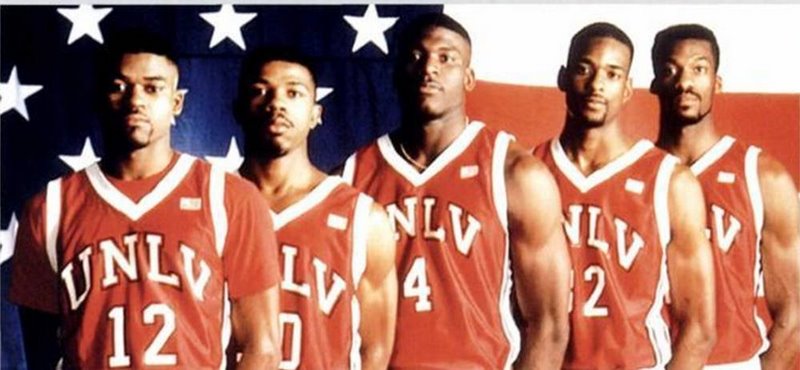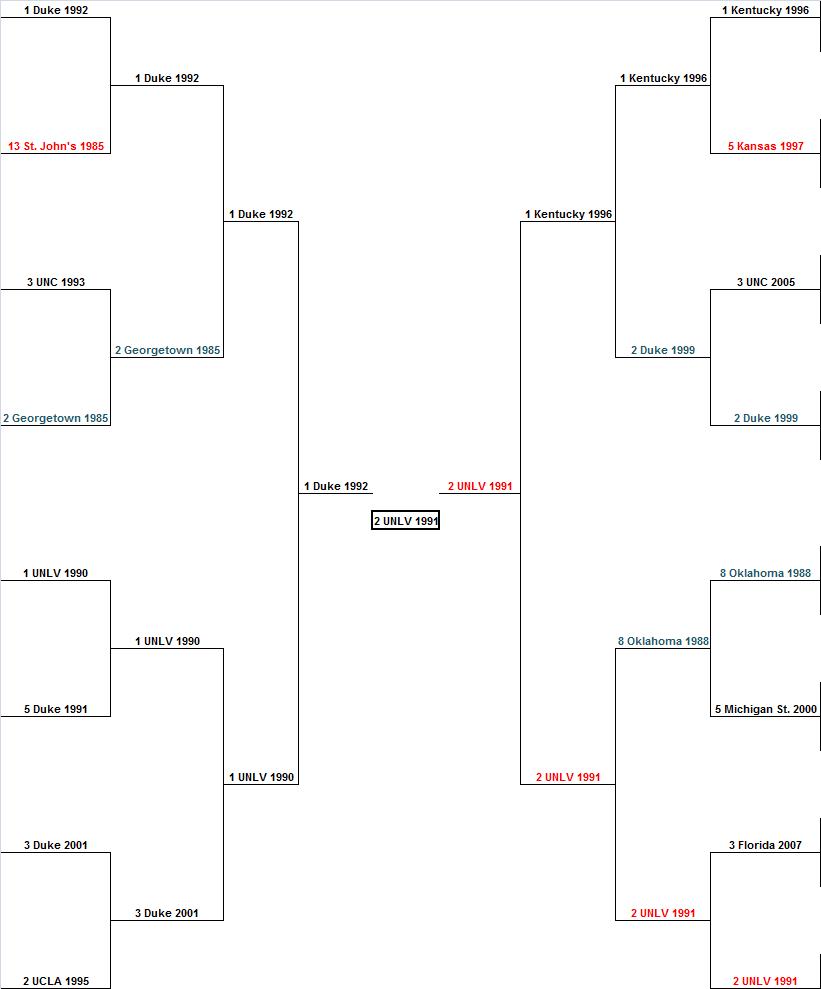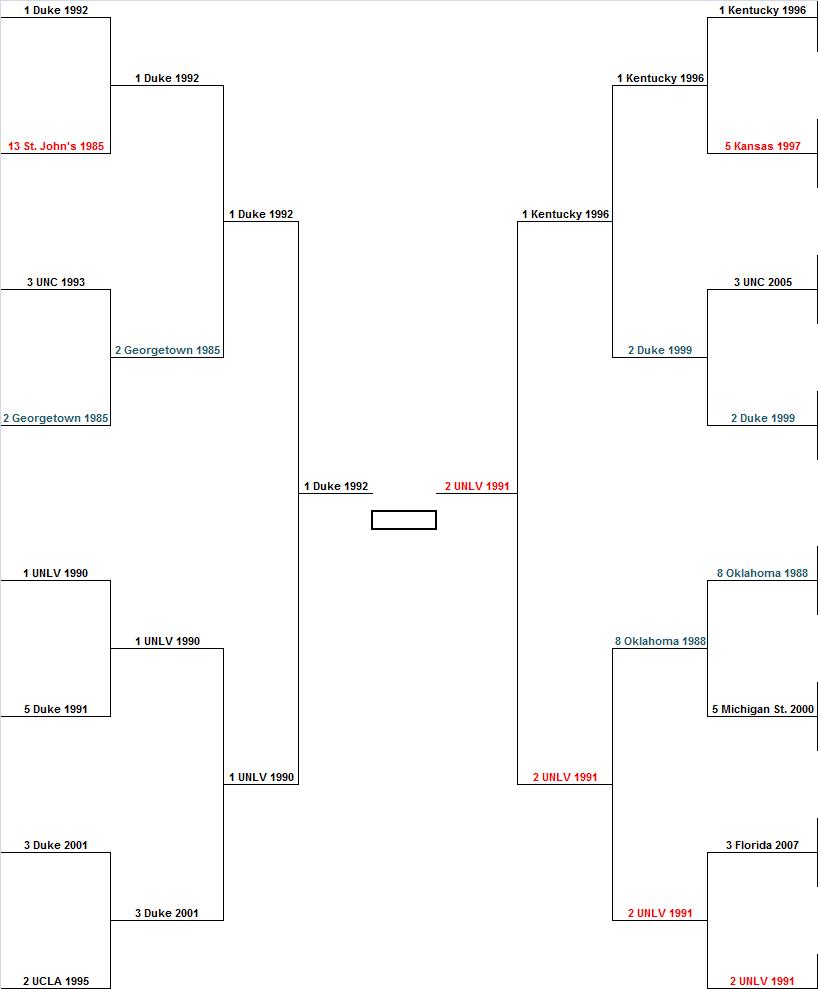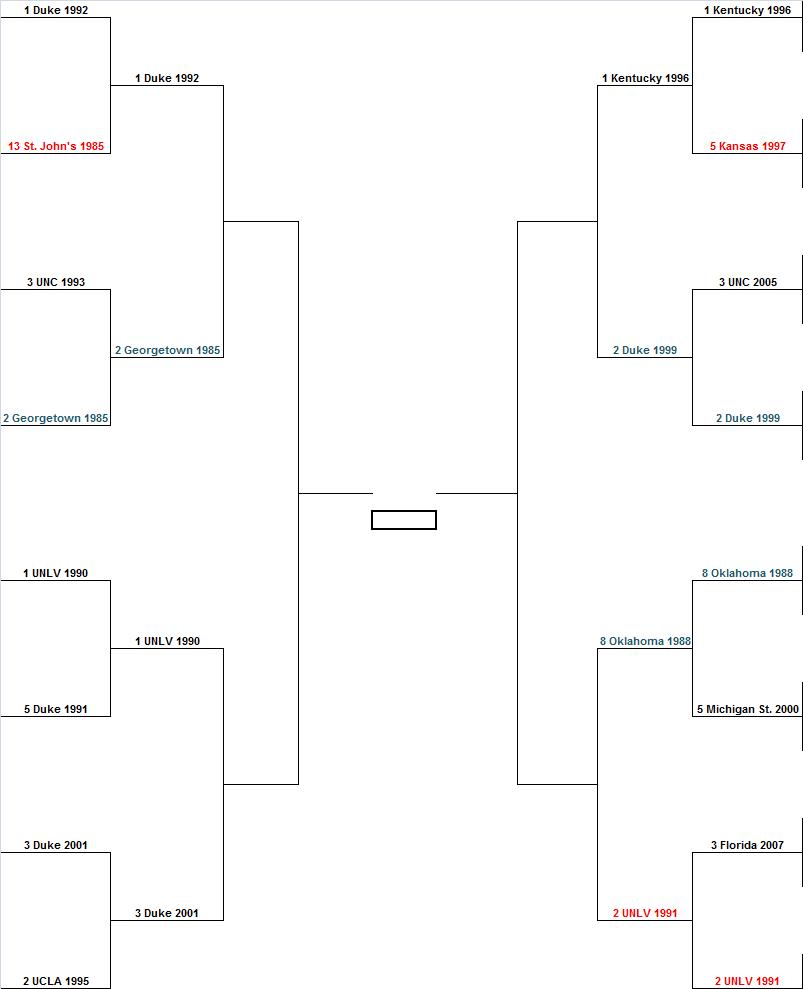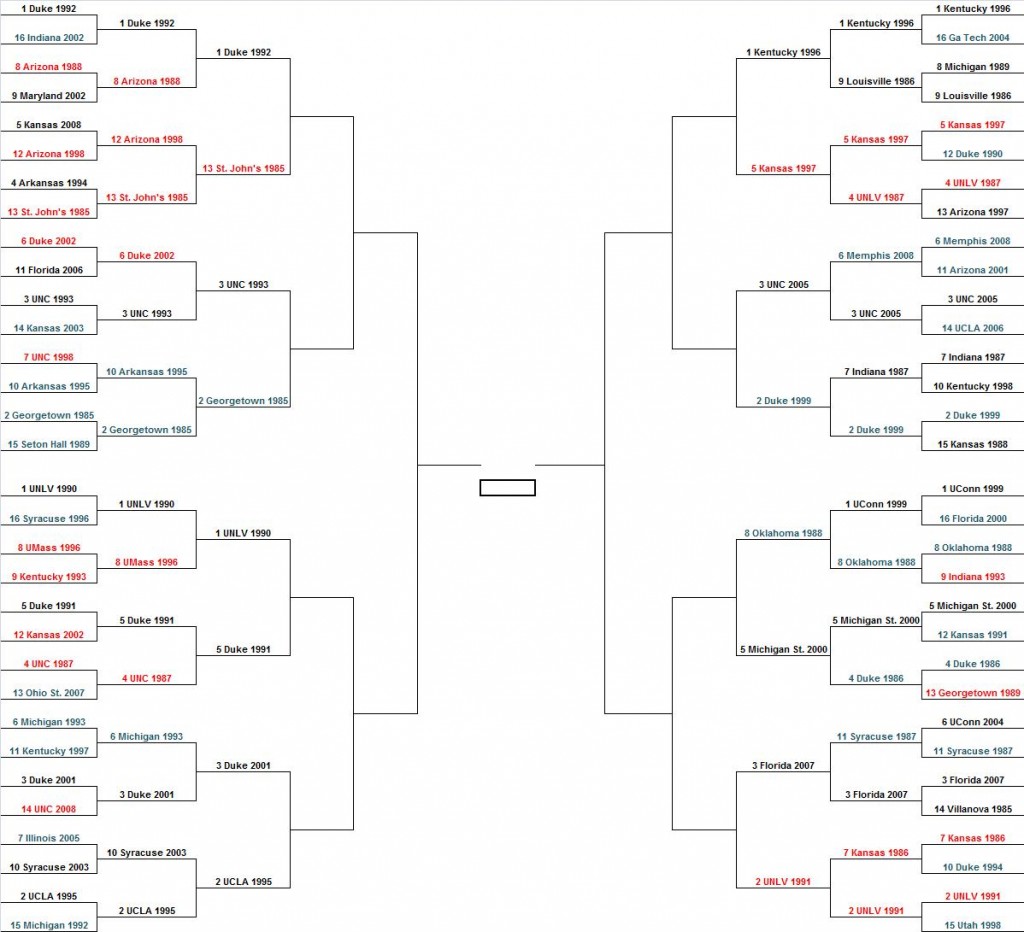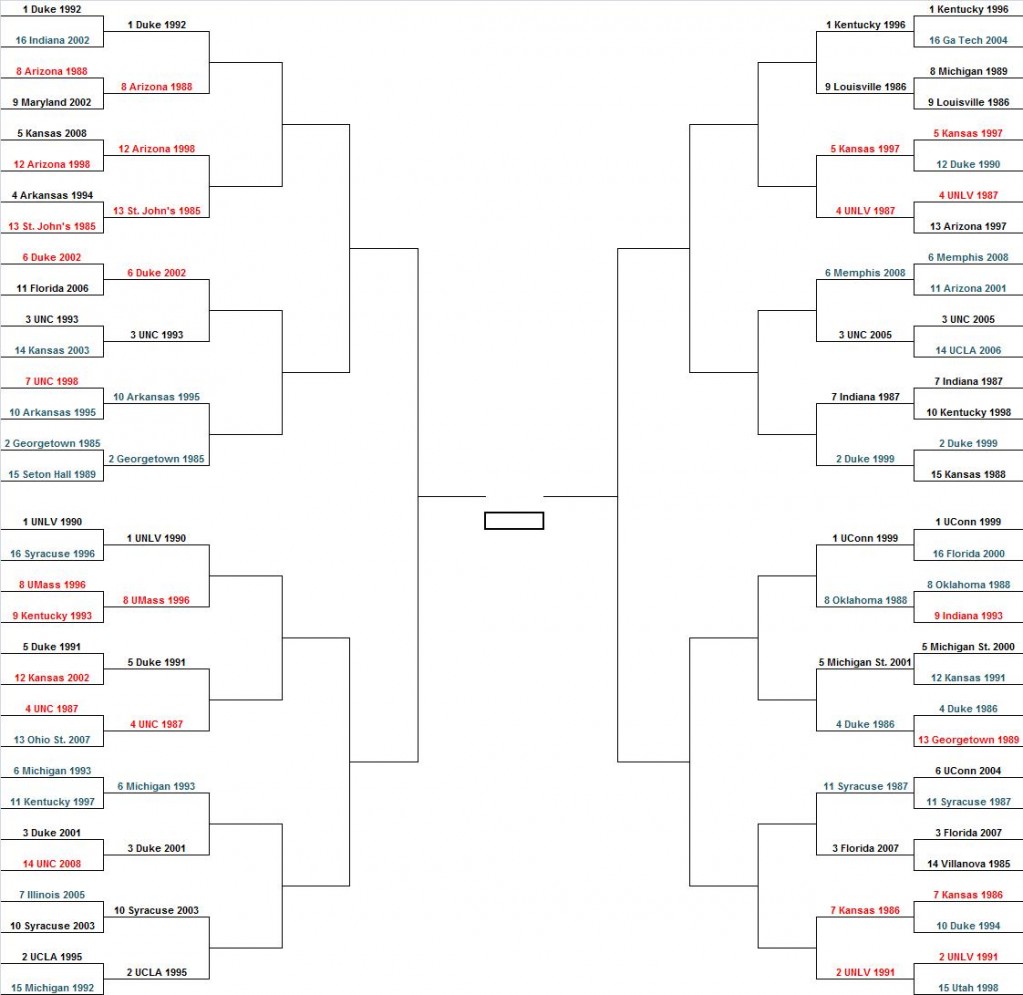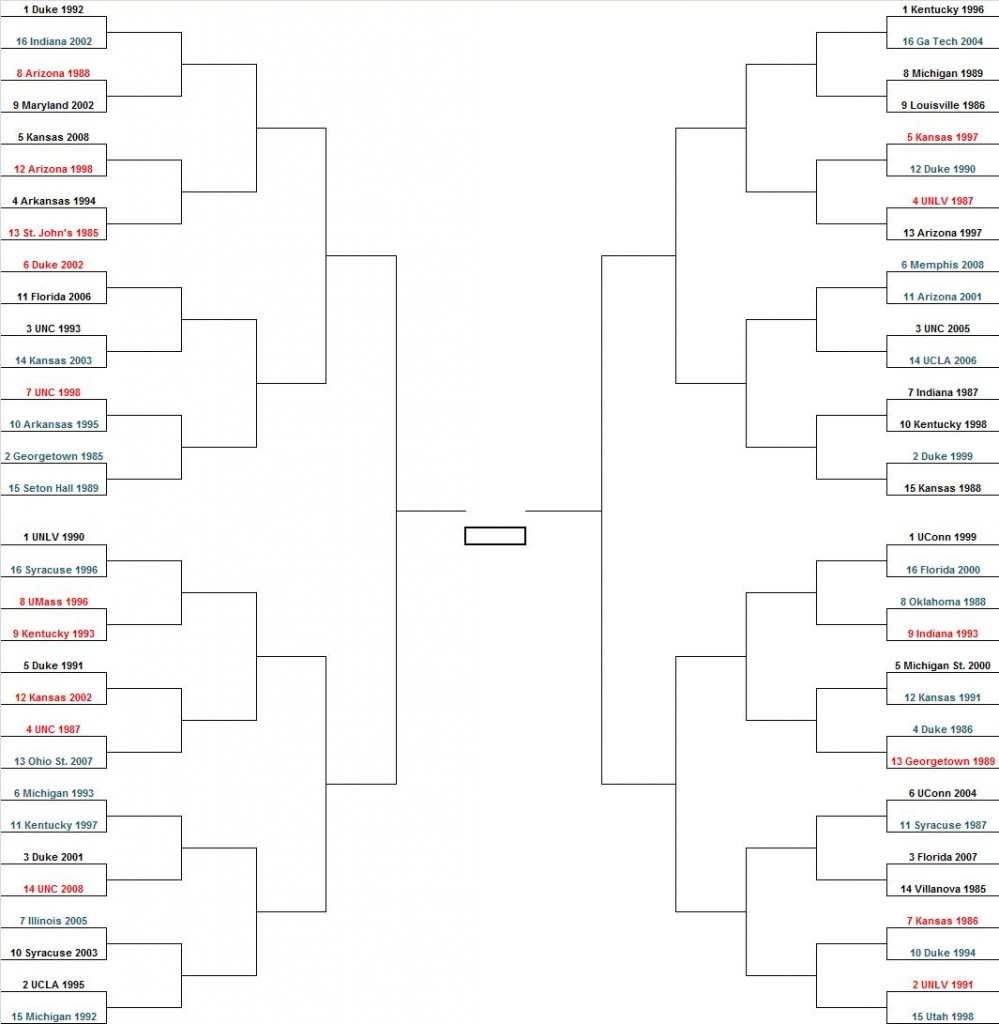Here we are, the Final Four of the RTC Modern Bracket – the four very best individual teams of the last quarter-century? Does anyone have any major issue with any of these four? If so, let us know in the comments.
We’re left with three #1 seeds and an unreal #2 seed, which happens to be the only team that didn’t win the national title during this span. The cream always rises, so they say.
For the full 64-team bracket, click here. The game analyses are below the bracket.
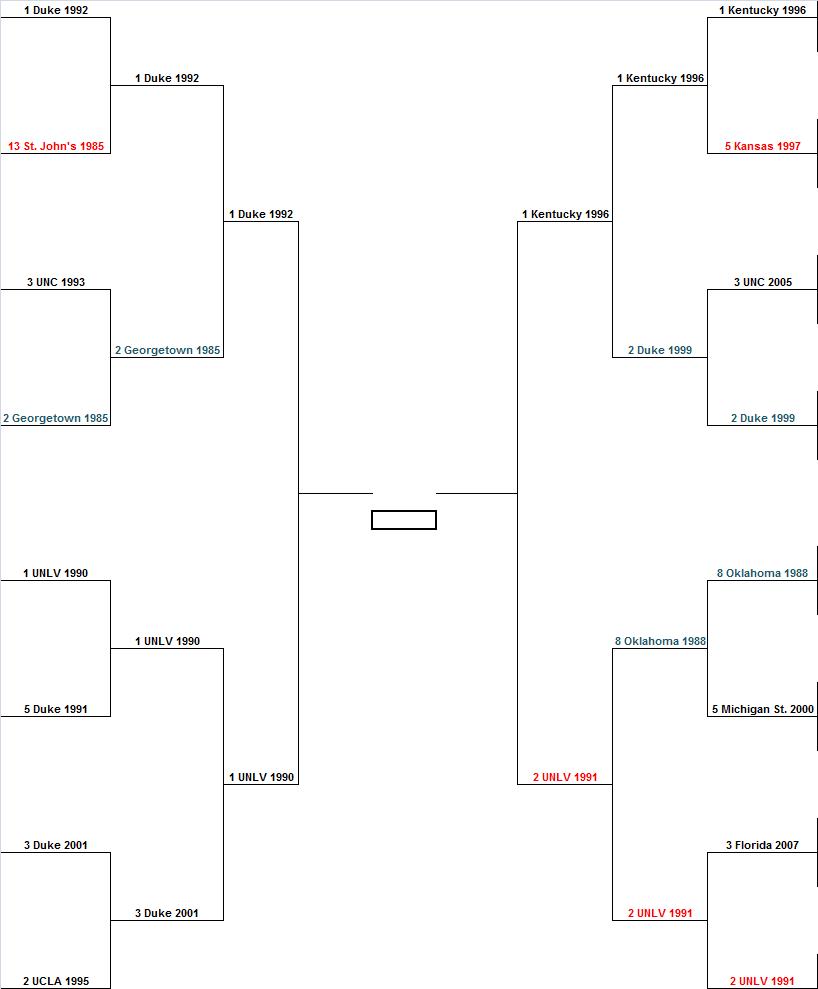
Instant Analysis
#1 Duke 1992 def. #2 Georgetown 1985 – Going into this game a lot of the older journalists were overheard talking about how Patrick Ewing will destroy Christian Laettner on the inside. When some of the journalists ask Coach K about this, he explodes and says that Laettner will be able to hold his own again and then he questions them on when the media and the country turned on him. After a pre-game pep talk from assistant coach Jay Bilas, Laettner decides to go right at Ewing, which has a predictable result (7 first half blocks for Ewing). Despite having a huge edge on the inside, the Hoyas are clinging to a 2-point lead because of Duke’s outstanding perimeter play. At halftime, Coach K convinces Laettner to stop trying to make this into a physical match-up because he has no shot at beating Ewing in the post. After halftime, Laettner hangs out about 18-20 feet away from the basket. John Thompson instructs Ewing to stay in the middle and make Laettner hit some shots from the outside, which he promptly does making three straight 3-pointers over a 2 minute stretch (after the game Thompson finds out that Laettner was 54/97 from 3-point range for the season). A confused Ewing, who never had to deal with a 3-point line in college, finally comes out and guards Laettner, which frees up the lane for Bobby Hurley, Grant Hill, and Brian Davis. After watching the Blue Devils build a double-digit lead against a disoriented Hoya team, which was accustomed to having Ewing clean up their mistakes when opposing guards got past them, Thompson calls a time out with 8 minutes remaining in the game. During the timeout, Thompson decides to put Reggie Williams on Laettner and keep Ewing back in the paint. The plan works wonders for the Hoyas as they come storming back to tie it with 20 seconds left on a rebound dunk by Ewing. Coach K calls his last time out and draws up a play that sets a double screen for Bobby Hurley to either shoot it from the top of the key or dish it to Laettner underneath. The play works perfectly except that Thompson, realizing that Coach K would go to his superstar, has put Ewing back on him for the last play. When Hurley comes around off the screen he has an open look but stumbles and dishes to Laettner. Laettner tries to draw a foul on Ewing with a couple pump fakes but the Hoya great doesn’t bite. In a last gasp attempt Laettner leaves his feet and Ewing finally does the same, but Laettner finds a streaking Brian Davis underneath as David Wingate and the rest of the Georgetown defense (and the 20,000+ in attendance) are transfixed on the two giants underneath. Davis, who had been quiet most of the night, lays it in as time expires to give the Duke 1992 team its second “Great Game Ever” victory.
#1 UNLV 1990 def. #3 Duke 2001 – On paper this looks like a great match-up with both teams loaded with NBA lottery picks, but the Runnin’ Rebels were perhaps the hottest team coming into the tournament and right off the bat their amoeba defense wreaks havoc on the Blue Devil offense, which lacks a true point guard. On the other side of the ball, the Blue Devils can’t keep the athletic UNLV guards in front of them. Even Shane Battier, the national defensive player of the year, gets lit up by Larry Johnson. With UNLV up by 20 points in the first half, Coach K calls a timeout and asks his players what they are scared of because they can’t get any more embarrassed than they already are. With the UNLV fans (read: local gamblers with thousands riding on the game) feeling pretty confident that UNLV (-6) will cover, they start the “Over-rated!” chant, which fires up Jason Williams who starts to pick apart the UNLV defense repeatedly abusing Greg Anthony and helps cut the lead down to 6 at halftime. During the halftime show, Seth Davis lays into Greg Anthony (version 1990) for his poor defense while his colleague Greg Anthony (version 2009) grows increasingly agitated. During halftime, Jerry Tarkanian decides to put Stacey Augmon on Williams in the hopes that his athleticism and length (a topic of great interest for Jay Bilas) can slow Williams. Much to the UNLV fans’ delight, it works wonders and Williams grows increasingly frustrated. Meanwhile, Greg Anthony, who is freed of getting abused by Williams, goes to work on Chris Duhon and picks apart the freshman and finds a red hot Anderson Hunt. Hunt’s 2nd half 3-point barrage leads the way as the Runnin’ Rebels win by a dozen. Walking off the court, George Ackles looks wearily at the group of the UNLV fans who are relieved that their team covered. After the game, Greg Anthony (version 2009) interviews Greg Anthony (version 1990) and they taunt Seth Davis mercilessly about how they are going to knock all the remaining Duke teams out of the tournament.
#1 Kentucky 1996 def. #2 Duke 1999 – The best game of the tournament. Top to bottom, these rosters may be the most talented in the entire tournament. Going into the game, Rick Pitino repeatedly uses the media to question the committee for their decision to put his Wildcats in the same region against what he considers the 2nd best team in the tournament. Once the game starts, the fireworks begin with Trajan Langdon hitting three 3-pointers in the first 5 minutes against Ron Mercer who responds by yelling at Antoine Walker for not showing off the screen. Antoine responds the only way he knows how. . . by taking back-to-back 3s on 3-on-1 fast breaks. Fortunately for the Wildcats, the rest of their game is clicking with Tony Delk matching Langdon from beyond the arc. Much to the surprise of Duke fans, the Wildcats interior players are able to contain Elton Brand with Mark Pope and Walter McCarty. They are able to do this despite having weaker players on the inside thanks to their ability to seemingly double Brand before the ball gets there, but still managing to not leave the Duke perimeter players open. After halftime, Pitino decides to put Derek Anderson on Langdon, who promptly shuts down the Duke All-American. In the end, Kentucky’s superior depth wins out with Delk and Anderson closing out the game at the free throw line. In his post-game press conference, a tearful Coach K talks about how upset he is that Trajan Langdon will leave Durham without a title, but tells reporters that they will never find a better person. After the game, Coach K soothes the Duke boosters by telling them that he has a feeling that his team next year may end up being his best ever with all of his players returning (nobody has left before) and the addition of Jason Williams, Mike Dunleavy Jr., and Carlos Boozer.
#2 UNLV 1991 def. #8 Oklahoma 1988 – After the previous game, which analysts are already calling the best of all-time, some analysts are wondering if this match-up of two up-tempo teams can possibly match what they just saw. The short answer: No. The first half looks promising with Mookie Blaylock and Stacey King running up and down the court matching UNLV and going into half the Sooners are holding a 60-58 lead. At halftime, Tarkanian lays into his team for not playing defense and he reminds them that defense is the one thing that this UNLV team has that the Sooners don’t. As halftime is ending,a stadium official informs Tarkanian that a man named Richard Perry would like to come into the locker room, but Tarkanian refuses to let him in, which raises a few eyebrows from the players. Having been read the riot act by the normally calm Tarkanian, the Runnin’ Rebels come out pressuring Blaylock and force him into four early 2nd half turnovers. By the 10 minute mark, UNLV has a 14-point lead and rolls from there. Following the game, when reporters question Tarkanian about whether his team can handle the pressure that Rick Pitino’s Wildcats will throw at them, he laughs and says that his team will be fine as long as they are focused and then offers to take the reporters out to meet a few of his lady friends.





























